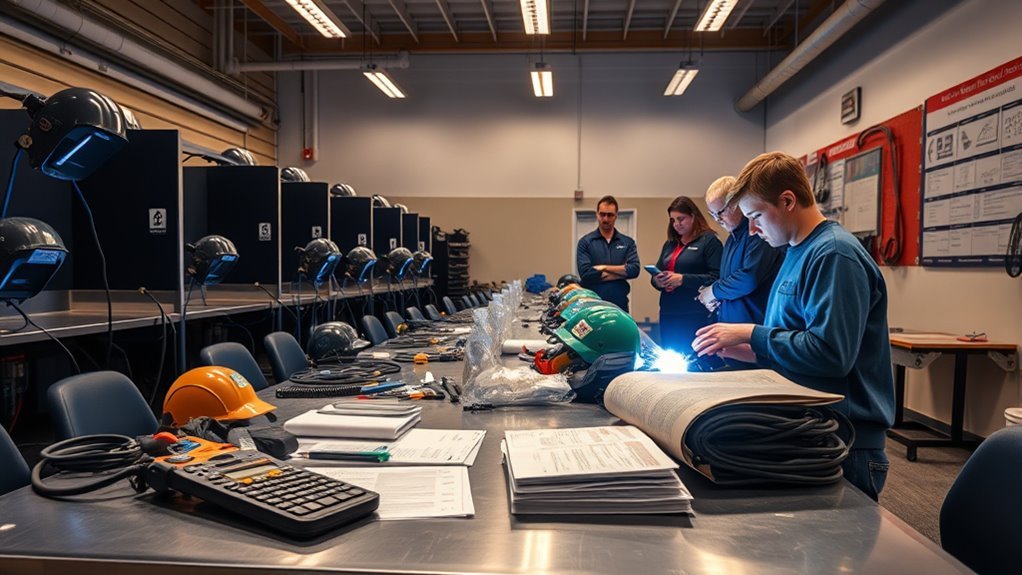You may not know that short welding certificate programs can cost as little as $3,000 while two-year associate degrees often top $25,000, depending on school and region. You’ll want to weigh program length, school type, and location because they shape both cost and job prospects. There are extra expenses for gear and certifications, and financial aid can change the math—so keep going to see which options fit your goals.
Average Tuition Costs for Welding Programs

On average, you can expect welding programs to cost between about $5,000 and $15,000, though some specialized or longer programs can top $20,000. You’ll see tuition variations driven by credential level and institution type.
Certificate courses run weeks to months and typically cost $3,000–$10,000, while one-year diploma programs fall around $5,000–$15,000. Associate degrees usually span two years and commonly range $10,000–$25,000.
Program comparisons show community colleges often offer the most affordable route—around $5,000 for a two-year curriculum—whereas private trade schools and four-year institutions push prices higher.
Don’t forget ancillary costs: safety gear and materials commonly add $100–$500, and a personal welding machine can be $500–$2,000, increasing your total outlay.
When you evaluate options, focus on total cost of completion, credential earned, and equipment needs to make a clear, practical choice that fits your budget and career goals.
Types of Schools and Program Lengths

Choosing where to train will shape both your costs and the depth of your skills: trade schools and community colleges dominate welding education, with certificate courses lasting weeks to months, one‑year diploma programs, two‑year associate degrees that add general education, and even four‑year bachelor’s tracks that blend welding with business or engineering.
You’ll find welding schools range from short certificate options (a few weeks to several months) to longer diploma, associate, and bachelor’s programs. Certificate program duration and cost are commonly shorter and cheaper—typically $3,000–$10,000—while one‑year diplomas usually run $5,000–$15,000.
Two‑year associate degrees, which include general education, commonly cost $10,000–$25,000. Trade schools may charge $5,000–$20,000 depending on program length and resources.
Bachelor’s pathways take about four years and generally carry higher tuition because they add business or engineering courses. When choosing, weigh program duration against your budget and the depth of training you need for your career goals.
Additional Equipment and Materials Expenses

Expect to pay more than tuition for welding school because you’ll need safety gear, tools, and supplies that can add hundreds or even a couple thousand dollars to your total cost.
You should budget $100–$500 for basic safety gear and materials tied to practical training, but prices vary by program. Essential hand tools and consumables often push that subtotal higher; some programs list tool kits near $1,106.91.
Budget $100–$500 for basic safety gear; full tool kits can reach about $1,106.91, so expect higher costs.
If your course requires a personal welding machine, expect $500–$2,000 more depending on type and brand. Add $100–$500 for books and course supplies you’ll need to complete assignments and labs.
That means additional equipment and materials can greatly increase your outlay beyond tuition, so plan accordingly. Buy quality safety gear — gloves, safety glasses, a certified welding hood — because they protect you during practical training and last longer.
Track required items from your school so you only purchase what’s specified and avoid unnecessary expense.
Financial Aid, Scholarships, and Payment Options

You can cut the sticker price of welding school by combining scholarships, grants, and small federal or private loans.
Look for awards from schools, associations like MTI, and GI Bill® benefits if you qualify, and ask about institutional payment plans that spread tuition into manageable installments.
Apply to multiple aid sources early so you can mix grants, scholarships, and low-interest loans to minimize out-of-pocket costs.
Scholarship and Grant Sources
Looking for ways to lower the cost of welding school? You should start by targeting scholarship eligibility early: check criteria from professional groups like the American Welding Society and school-specific awards such as MTI’s scholarships for high school seniors.
Apply broadly—each fund has unique requirements and deadlines. For grants, treat a grant application like a job submission: gather transcripts, a concise statement of need, and any required documentation, then submit to federal, state, and institutional sources.
Grants don’t need repayment, so prioritize them before other financing. MTI participates in federal aid and offers veteran benefits like the GI Bill®, so verify institutional grants and scholarships with the school’s financial aid office to maximize non-loan support.
Loans and Payment Plans
While grants and scholarships should come first, federal student loans and institutional payment plans can bridge any remaining gap when welding programs cost between about $5,000 and $30,000. You’ll explore loan types with lower interest rates and flexible repayment options, use grants that don’t need repayment, and pursue targeted scholarships from schools and trade groups. Many schools offer payment plans so you can spread costs and preserve cash flow. Veterans can use GI Bill® benefits; institutions like MTI provide financial aid counseling to coordinate sources. Compare total cost, terms, and payment flexibility before borrowing. Use the table below to track options and estimate out-of-pocket needs.
| Source | Typical Benefit | Notes |
|---|---|---|
| Grants | $500–$5,000 | No repayment |
| Loans | Variable | Check loan types |
| Payment Plan | Installments | Institutional flexibility |
Certification, Licensing, and Exam Fees

Certification and licensing costs for welding typically fall between $200 and $500, though exact fees depend on the credential and issuing organization. You’ll find AWS Certified Welder exams around $300, and other certs vary within that range.
Even in states without mandatory licenses, like Illinois and Missouri, employers often prefer or require certifications, so certification benefits directly affect your job prospects.
Even where licenses aren’t required—such as Illinois or Missouri—employers frequently prefer or require welding certifications, improving job prospects.
Expect additional exam preparation costs: prep courses or study materials can add $100–$500 unless your school covers them. Some welding programs include certification fees in tuition; verify what’s included before enrolling to avoid surprises.
When budgeting, factor the exam fee, any resit charges, and prep expenses. Pay attention to which certs are recognized in your target industry and by local employers.
Prioritize certifications that match the work you want, plan your exam preparation timeline, and confirm whether your training provider bundles testing to reduce out-of-pocket cost.
Comparing Return on Investment by Industry and Region

Because industries and regions vary so much, you should weigh where you plan to work as carefully as what you study: a $5,000 community-college program in Texas can yield far higher ROI if you enter oil-and-gas or shipbuilding than a pricier trade-school program in a low-demand area.
Targeted AWS certifications or paths into aerospace and underwater welding often translate into noticeably higher wages and promotion potential that repay initial costs over time. Use welding industry analysis to compare median wages—$47,540 nationally (May 2022)—against sector pay where oil, shipbuilding, and aerospace pay a premium.
Factor regional job trends: Texas and California typically offer higher openings and salaries, boosting ROI and shortening payback periods. Compare program cost ranges ($5,000–$20,000) to projected starting pay and certification premiums.
Also weigh long-term mobility: supervisory, underwater, or aerospace roles raise lifetime earnings. Running a simple cost-versus-earnings projection for your target industry and region will show which training route gives the best return.
How to Choose the Right Welding Program for Your Goals

How do you pick a welding program that matches your career goals and budget? Start by defining your career aspirations—do you need a quick certificate to enter the trade or an associate degree for supervisory roles?
Match program length and type to that goal: certificates take weeks to months and cost $3,000–$10,000; associate degrees take two years and run $10,000–$25,000.
Check program reputation and hands-on training availability; trade schools and community colleges often emphasize practical skills and average $5,000–$15,000.
Prioritize programs with strong reputations and plenty of hands‑on training—trade schools and community colleges focus on practical skills.
Factor in equipment and materials, which can add $100–$2,500 depending on techniques taught.
Investigate job placement services and industry partnerships; strong connections improve hiring odds.
Finally, research financial aid—scholarships, grants, and federal loans can substantially cut costs.
Compare total outlay, training quality, and placement outcomes to choose a program that fits both your finances and long-term goals.
Frequently Asked Questions
Can Previous Work Experience Reduce Program Length or Cost?
Yes — your work experience can shorten program duration and cut tuition; schools often grant credit or waivers for prior skills, so you should document training and job history to negotiate reduced coursework and overall cost.
Are Online Welding Theory Courses Accepted by Employers?
Yes — but don’t expect applause: you’ll need reputable online course credibility, solid hands-on proof, and certifications employers prefer. Employer preferences lean toward accredited theory plus practical welding experience, so blend both to get hired.
Do Employers Reimburse Welding Training Costs After Hiring?
Yes — many employers offer training reimbursement and other employer incentives; you’ll often get tuition repayment, certification support, or apprenticeship pay-back options after hiring, though availability and amounts vary by company, region, and your role.
How Does Welding Program Accreditation Impact Job Placement?
Accredited welding programs boost job placement by signaling quality and providing accreditation benefits like standardized curriculum and employer recognition; you’ll gain better job readiness, stronger industry connections, internships, and higher employer trust for faster hiring.
Are There Community Discounts for Veterans or Seniors?
Yes — you’ll often find veteran benefits and senior discounts at community colleges and trade schools; call programs directly, check VA education resources, and ask about tuition waivers, reduced fees, scholarships, or sliding-scale options for seniors and vets.
Conclusion
Studying welding can fit many budgets, but plan carefully: tuition ranges from about $3,000 for short certificates to $25,000+ for two‑year degrees, plus $100–$2,500 for gear and $200–$500 for certifications. Use scholarships, grants, and payment plans to lower costs. Think of choosing a program like picking the right torch—matching heat and tip to the job guarantees sparks fly toward your goals. You’ll get better returns when training matches your target industry and region.


